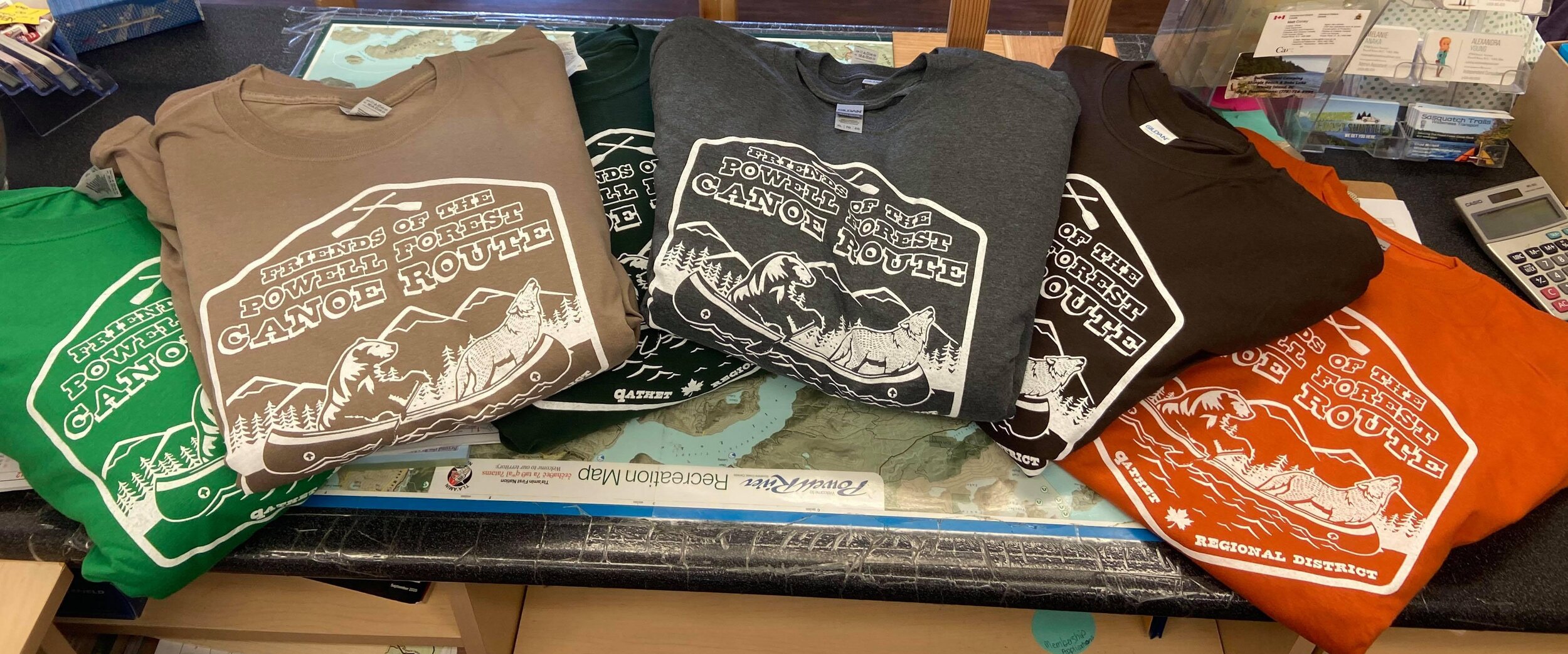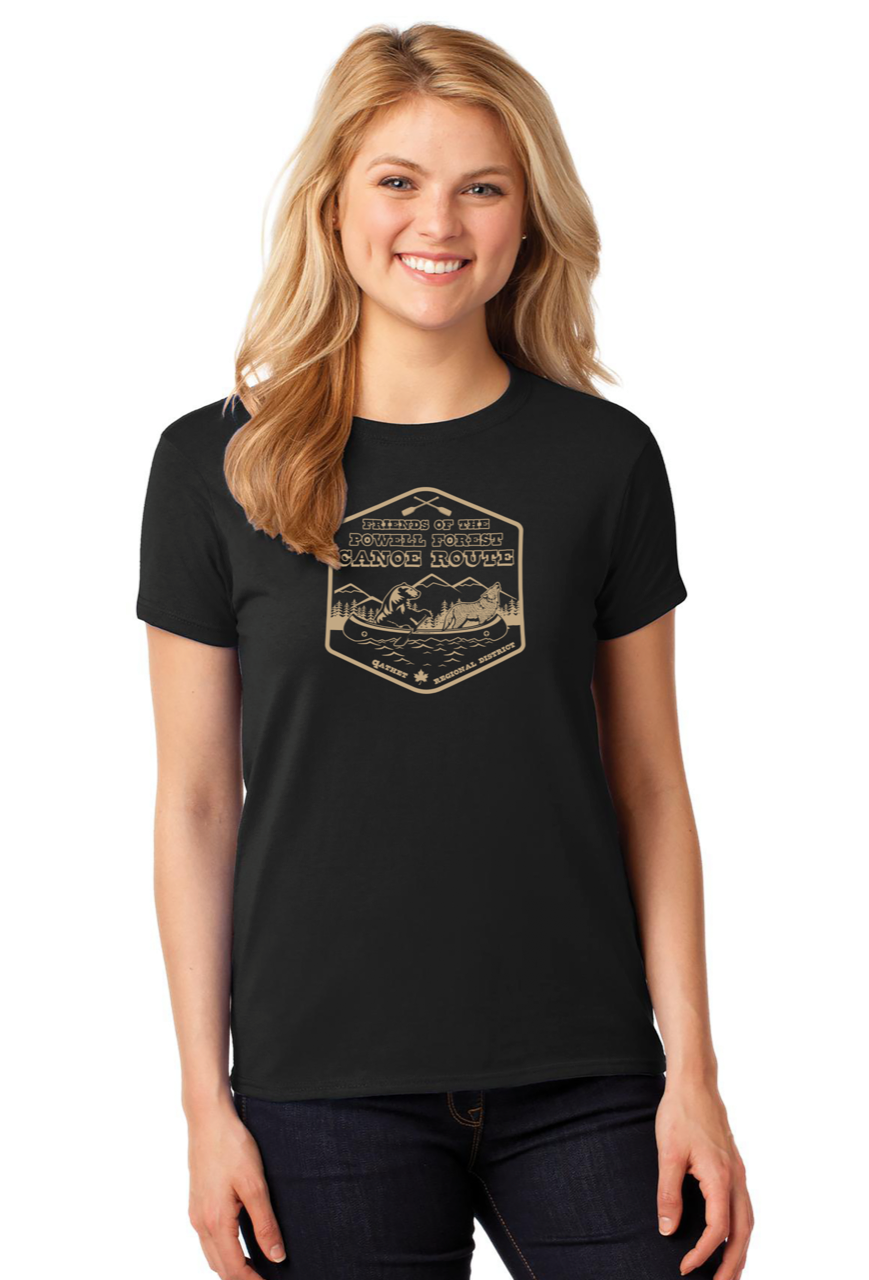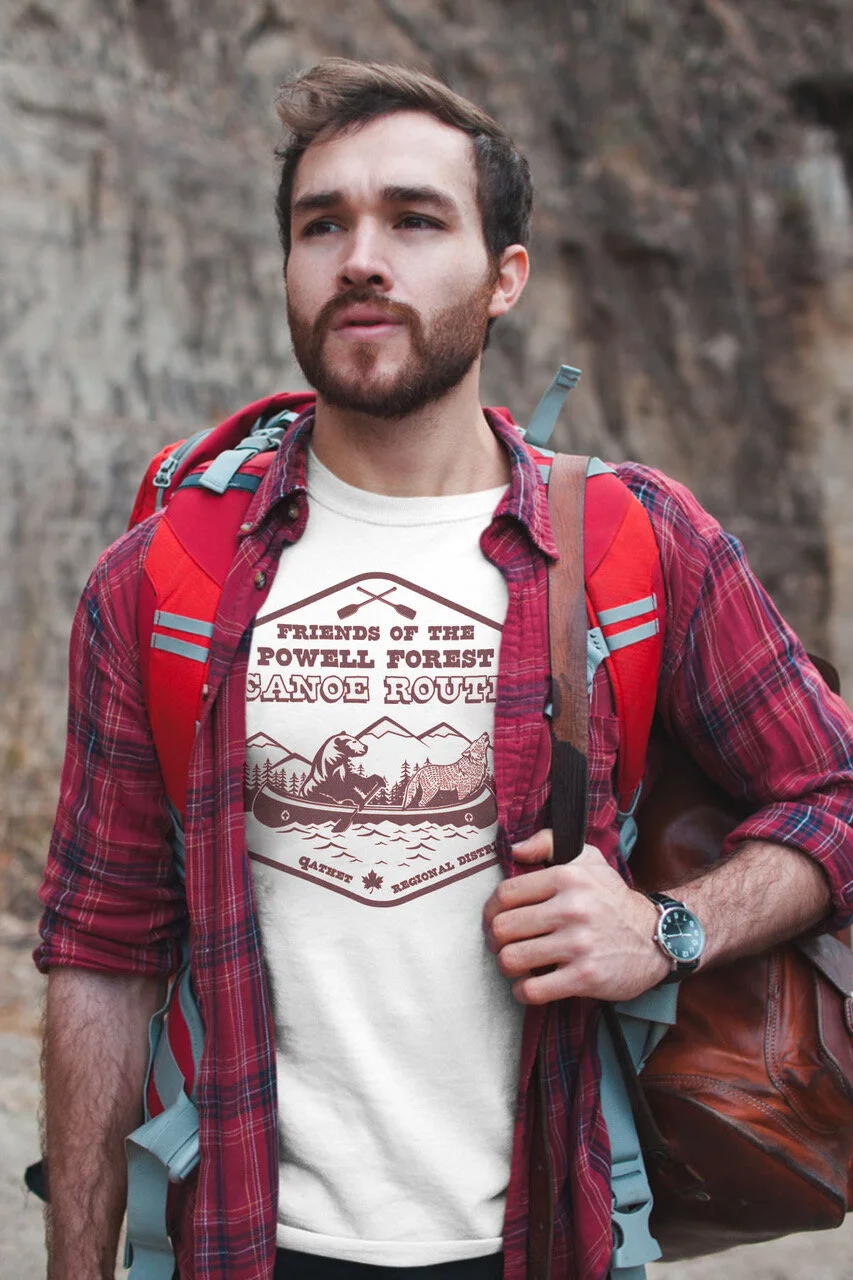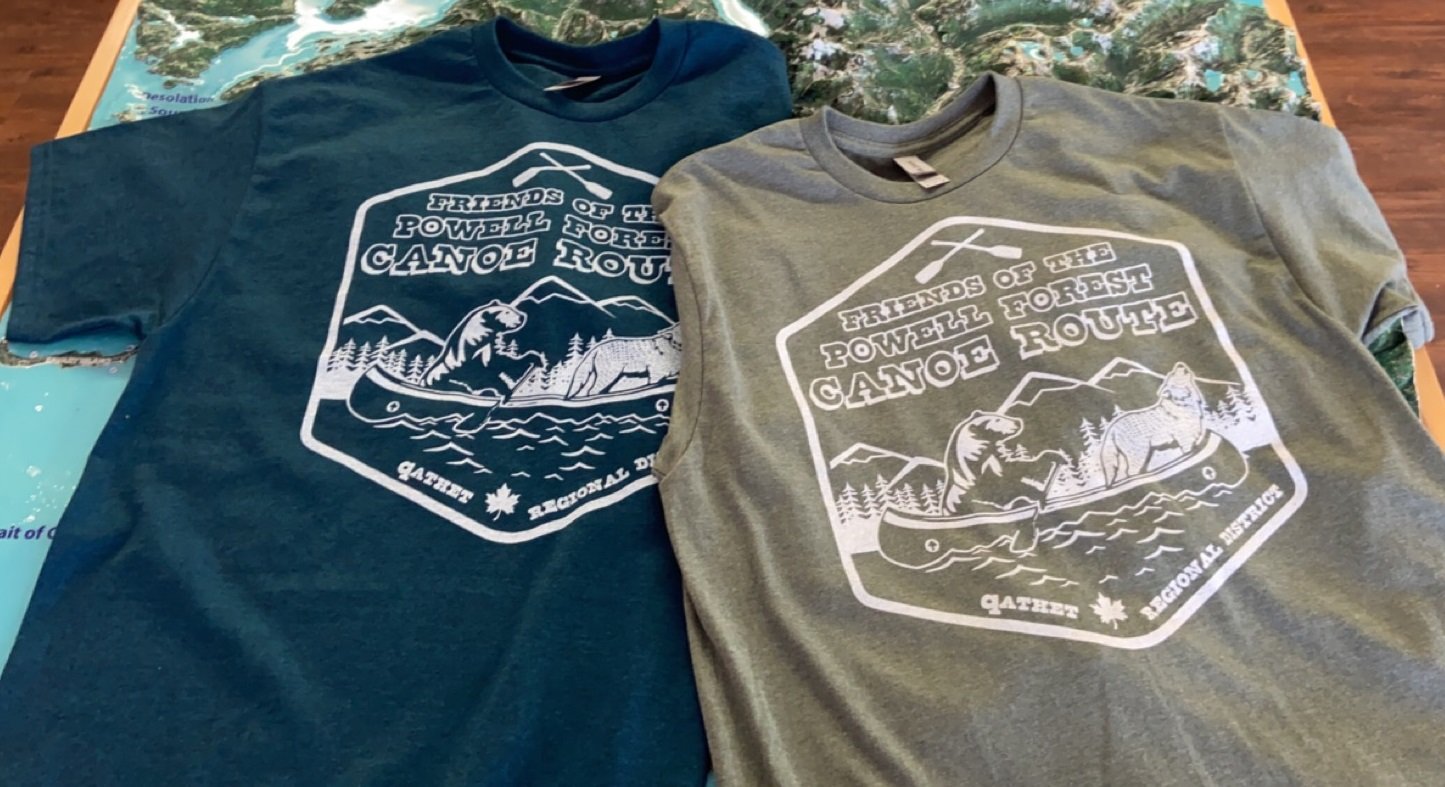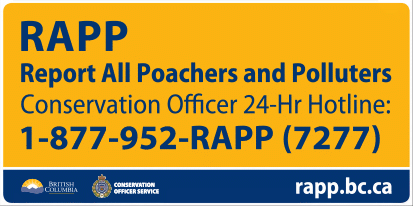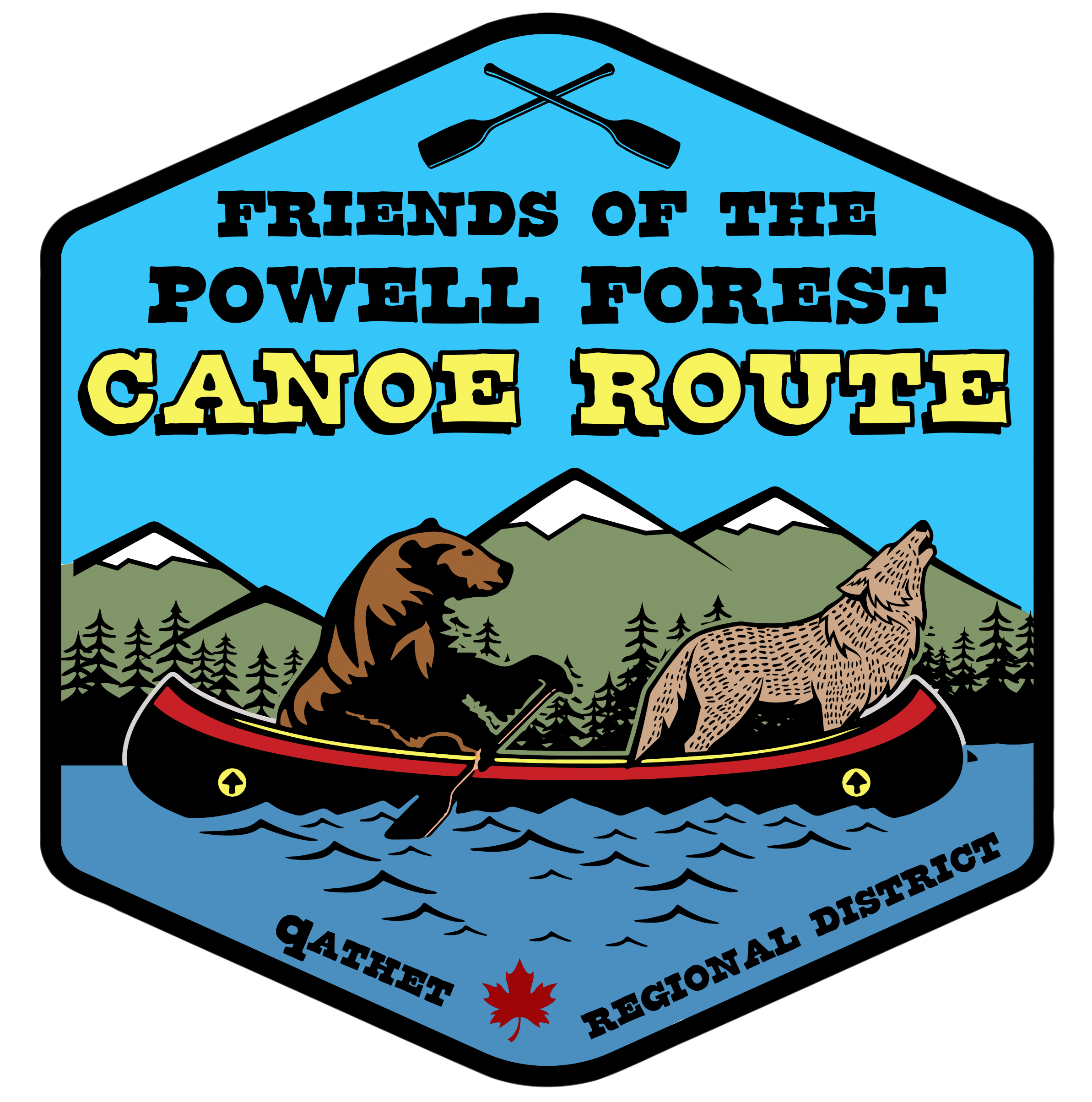WHERE DO WE START THE ROUTE
The traditional direction to do the route is from Lois Lake (counter clockwise) to Powell because of the steep downhill portion of the Windsor (elev. 196 m) to Goat (elev. 85 m) portage.
Over the past several years we have had groups successfully complete the route clockwise; Powell to Lois Lake. It is a lot of effort to portage the 111 m ascent from Goat to Windsor, but the benefit is that the prevalent afternoon winds on Powell tend to be in your favor. These groups prefer swapping Powell’s (typical) head winds, for the predictable, and anticipated uphill grind.
The route is well marked with fluorescent orange triangles (mostly faded to white by the sun).
A lovely Belgium family made this video of their Powell Forest Canoe Route adventure.
TRANSPORTATION
This isn't a circuit. It’s shaped like a horseshoe. The beginning and end are 30 km’s apart. You could do your own transport if you have two vehicles, but it takes a couple of hours; before AND after your adventure. Save yourself the time, gas, and extra ferry fares by hiring Sasquatch Trails for the Powell Forest (qathet) Canoe Route (and all of Powell River’s water). Best of all, you’ll get a discount on the transport of your rented canoes.
Sasquatch Trails is DOT and National Safety certified with a commercially inspected vehicle and a Class 4 licensed driver who knows how to protect each watercraft from transport damage.
There have been a few instances where “Joe Blow” has offered a ride to canoeists and their gear. This has caused boat damages that you, the renter, has had to pay for.
HOW MANY DAYS DOES IT TAKE
You can do the Powell Forest Canoe Route, in qathet BC, in five days, but your days are basically moving from 8 am to about 3 to 5 pm. You have to break camp every day. Five days does allow you to paddle Powell Lake over two days; focusing on the mornings and evenings to avoid the winds. Yes, you can take the whole middle part of the day off on the sandy beach (upper Powell campsite) to relax, read, eat, have a nap . . . .
My favorite is doing the route over six days. This way, you camp at my two favorite spots; Windsor and Goat. This means that you do that steep portage over one whole day! Or, if you happen to move through the route quicker; have a down day. Time to relax, swim, tan, read, fish, etc.
Should you pick the west side including Nanton and Ireland Lake, or the east portage path of Little Horseshoe / Little Beaver Lakes?
The west side is longer, but the trails are flatter and generally better footing. The long portage follows a creek too. There are less transitions between paddling and portaging on the west side.
If you are planning on fishing, or you want a quieter time, then the east side is better.
MAPS
We have the fold-out map of the route in our shop. To get a copy before your trip email tourism or call +1 604-485-4701.
WANT MORE ADVENTURE?
There are side trips you can add on without extra portaging:
Khartoum Lake: You paddle east on Lois, through an obvious narrows. There is a campsite on Khartoum as well.
Inland lake: The portage trail between Lower Powell Campsite and Inland Lake has not been brushed out in a decade (or more). It is not easy to find. I do not recommend portaging it. Some do find it and enjoy the adventure into Inland Lake (watch for evidence of old logging equipment) and walking the beautiful wheelchair access trail around the entire lake, having a snack on Anthony Island, swimming to Mud Island, etc. Then walk back to camp on Powell Lake.
Another option is to paddle up Goat Lake towards the mouth of the Eldred River.
ONLY HAVE FOUR DAYS
Do the small circuit, which starts at Lois, takes you up to Dodd and then back to Lois. You still get in seven different lakes and access the great little fishing lakes - Little Horseshoe & Little Beaver.
ONLY HAVE THREE DAYS
Start at Windsor Lake and descend to Lois. You still get in a large portion of the route.
We prefer to get the hour long transport over with at the beginning. This way you will be traveling towards civilization (if you should encounter any problems).
Pick up at the Lois Dam is only 20 minutes from our shop (if you have a ferry to catch, it will be easier to gauge your timing).
BTW - You can camp in the spot we drop you in at Windsor, but there is a beautiful campsite about a 25-minute paddle away.
ONLY HAVE TWO DAYS
Start at Dodd Lake and descend to Lois. Or, if you are not interested in portaging, paddle Lois east, go through the narrows into Khartoum Lake, and back.
WHERE TO CAMP
These campsite are free use. No permits required.
A six day trip usually plans out like this:
1st night - Lower Horseshoe Campsite
2nd night - South East Dodd Campsite
3rd night - Windsor Lake Campsite
4th night - Goat Lake Campsite
5th night - Lower Powell Campsite
As far as camping spots, you are limited to designated areas as this forest is either deciduous covered lowlands or mountain peaks surrounding these fjord-like lakes.
Each campsite has picnic tables, out house, somewhat flattened tent sites, and a fire ring (sometimes firewood). We still recommend cooking on a stove.
These campsites are very clean. If everyone keeps managing their garbage, they will remain this way. Use your best judgement and practice low-impact camping.
This is a great video on how to wash your dishes in the backcountry. We also sell biodegradable soap at Mitchell’s. See it at the bottom of this page.
THE CAMPER’S CODE HAS 9 RULES THAT ARE REALLY EASY TO FOLLOW. WHEN ALL CAMPERS FOLLOW THEM, GOOD THINGS HAPPEN.
PORTAGE DETAILS
1st portage from Lois to Horseshoe is 1.7 km (about 30 minutes).
2nd portage from Nanton to Ireland Lake is 3.1 km (about 45 minutes).
3rd portage from Ireland to Dodd is 0.94 km (about 17 minutes).
4th portage from Dodd to Windsor is 0.8 km (about 15 minutes).
5th portage from Windsor to Goat is 2.7 km.
You don’t have to wear heavy hiking boots. A hi-top runner would suffice. A blister kit is much appreciated if you find yourself in need.
We do not recommend you portage the canoe and gear in one trip. Take your backpack through first, then go back for the canoe. You have plenty of time to do each portage twice. Enjoy this outdoor experience.
There are frequent canoe rests (about every 300 meters) throughout every portage so that you can get the canoe off of your shoulders easily. Some of these canoe rests are double, others have a single log between two trees, so just put the bow on the rest and the stern on the ground.
You can generally use two people to get a canoe off the ground and onto the portagers shoulders, but if you want to try your hand at a solo lift, watch this video for proper technique. This article will give you some portage tricks too.
PORTAGE SAVVY
The comforts you bring have to balance with the weight of backpacking it. Do not bring coolers (too heavy and a bear attractant). Try to limit each person to one backpack and one fanny pack (for water, snack, camera). It is much easier to pack things on your back than to carry them in hand. Portaging is half of this trips effort, so think lightweight & compact.
PORTAGE TRICKS:
Bring sleeping foam to duct tape around the canoe yoke. No duct tape can touch the yoke - wrap the foam 100% around the yoke.
Knee pads (all soft/no hard plastic) work great strapped/Velcro-ed around the yoke too. We rent knee pads for $1 day.
ANOTHER TIP: Occasionally drop one arm to your side, gripping the other gunwale with the other arm, making sure it's outstretched and your elbow is straight. Then switch. This technique transfers the weight from one shoulder to the next, gives each shoulder a break.
PORTAGE ETIQUETTE: A person carrying a canoe should always be given the right of way.
All packs and canoes should be stored to the sides of the trail so all users have a clear path.
If you're holding up others walking behind you, let them pass.
IDEAL BACKPACKING SYSTEM
Each canoe (2 people) has a 70 - 115 liter dry bag backpack and a backpack canoe barrel. A 30 liter barrel will suffice for two people’s worth of smelly stuff, but is not big enough to fit in anything much beyond that.
If you use a 30 liter barrel we recommend also using a 30 or 40 liter dry bag backpack so that that person has a total of about 70 liters of packing space. You can pack the barrel on your back and the dry bag on your front at the same time. The balance of this makes it more comfortable than you think.
If you use the 60 liter barrel you can fit a lot more in it OR if you are a group of 2 canoes, the 60 liter barrel is perfect for all 4 people’s smelly stuff. Then the other three people use 70 - 115 liter dry bag backpacks.
If you own a fabric backpack, be sure your rain cover is waterproof. If you have two rain pack covers, you can put one over the strap side during paddling (so the straps don’t get wet laying in a wet canoe). Or, you could buy those huge garbage bags, but bring a few to outsmart the “hole” monster.
Mitchell’s rents all this gear. Click here for rental rates.
PADDLING OPTIONS
The most popular tandem paddle combination on our route is using an extra long kayak paddle in the bow and a canoe paddle in the stern (with a spare canoe paddle).
Your ideal bow paddler is a powerhouse to minimize stern correction strokes. A kayak paddle (of at least 260 cm) allows the paddler to smoothly and efficiently paddle at a more rapid rotation, while protecting the wrists from the the higher mobility demanded of a canoe paddle.
We even have canoeists rent an extra long kayak paddle for the bow and stern, with a canoe paddle as the spare. It takes a bit more effort to J-stroke with a kayak paddle, but less correction strokes will be needed overall if kayak paddles are used.
It’s also nice to switch between using a canoe and kayak paddle as each utilizes different muscles.
CANOE WHEEL CARTS
Carts do not work on our route. The trails are cut narrow to keep traffic low.
Keep in mind that every portage has frequent canoe rests so you can get the canoe off your shoulders without having to put it on the ground AND all of our canoes have molded yokes for solo portaging.
BEARS AND OTHER CRITTERS
Bears have not yet learned that these campsites are a food source but they are out there; Grizzly & Black Bear. You may see them. Do not approach.
Educate yourself on Grizzly bears by clicking the “safety” tab in this link.
Keep your group close together and talk loudly. Remain alert for fresh signs of bears (scat, tracks, claw marks on trees, overturned logs) and listen for them.
We recommend securing your smelly items (food/deodorant/ toothpaste/dog food) in a backpack barrel (which we rent). There are some bear caches out there too. You can try to hang a bag up in a tree, but the branches are really high around here...
Never leave attractants unattended or bring them into your tent.
Carry bear spray in an easily accessible yet protected area and know how to use it.
Be sure to leave every campsite clean.
Click here for more details on wildlife safety.
PREPARING FOR RAIN
June through September is drier, but we still recommend bringing a full set of rain gear and a plastic drop sheet (in a hardware store’s paint section) to put INSIDE the bottom of your tent if your tent does not have a waterproof (tarp) floor.
Tarps are a must too. It works best to have one cover your tent area and one cover your kitchen area. Bring lots of rope/twine to ensure you have enough to secure a ridge line and the four corners for each tarp.
This is the best quick deployment tarp system. Easy to put up & take down, rain or shine. The tarp is from DDTarps.
DRINKING WATER QUALITY
We do have excellent water in Powell River (qathet), but you should still treat it with a filter, tablets, or a one minute rolling boil. Take your water from any lake, ideally from deeper sections and below the surface.
FISHING
Cutthroat trout are the most abundant fish in Powell River (qathet). These fish are cannibals and like action lures such as spinners and flat fish with a lake troll. The Cutthroat, Rainbow, and Kokanee ( a tiny landlocked sockeye salmon) respond well to a trolled fly or a Rapala. Please note that these lakes take single barb-less hooks.
If you are the casting fanatic, early morning and evenings are effective because it is cooler. Fishing along the shorelines and around the islands are most effective.
You must have a current license with you at all times. You can purchase a freshwater fishing license online.
FOOD FOR THE TRAIL
Think light & compact.
We have a backpacker food manufacturer right here in qathet who uses only quality ingredients without any preservatives or extra salt. Wild Edge Keto focuses on super light, compact, dehydrated keto meals (for the non-keto too!) You can arrange to have your order waiting at Mitchell’s for the start of your adventure.
Wild Edge recipes:
Cuban Picadillo Wild Bison
Venison Chili
Sesame Ginger Wild Boar
Cajun Jambalaya
CANOE ROUTE SWAG
Want a souvenir from your outdoor adventure? Help support the not-for-profit society “Friends of the Powell Forest Canoe Route” through merch sales. To buy, and have shipped, email or call the Powell River Visitor Center at 604-485-4701.
T-Shirts - $24.99 Hats - $30 Decals - $5
BUGS
We don't have bad bugs. Head nets are not necessary, Just bring bug spray.
DOGS
Dogs are allowed on the route, but you must be the BEST dog owner and a lover of ALL dogs by cleaning up after yours. Leave no trace. This ensures future dog buddy’s get to adventure with their family.
Keep all dogs on leash as they can provoke defensive behaviour in bears. Do not let them chase wildlife.
To give your dog the most comfort in the canoe, please put sleeping pad foam under him/her. This protects the canoe and gives your furry buddy good grip / surety of movement.
THINKING YOU'D LIKE TO KAYAK THE ROUTE?
As far as kayaking the Powell Forest (qathet) Canoe Route, it is much more challenging than canoeing. It is very awkward to portage a kayak (even if you have installed a removable yoke or developed a sling system), and it takes two people. It is tiring to portage a kayak at arm's-length. Keep in mind that you may have to portage two kayaks if you are paddling with others. It only takes one person to portage a two-person canoe which means you can take turns packing it at each canoe rest. Also, kayaks tend to be heavy.
Packing your gear in a kayak requires multiple dry bags versus packing everything in a backpack in a canoe. Again, it is tiring carrying multiple dry bags through the portages.
NOTICED AN ISSUE WHILE YOU ARE OUT THERE?
The RAPP program is a toll free tip line and online service that also allows you to report known or suspected violations of fisheries, wildlife, or environmental protection laws anonymously and without risk of confronting the offender.
Available 24/7, RAPP is simple, safe and effective.
HISTORY OF THE ROUTE
The canoe route area has a logging history dating back to the early 1920’s, which adds to the uniqueness of this canoe adventure. Evidence of old logging practices can still be found along the route; a 1930’s corduroy road (the use of horse pulled sleds with greased wooden runners to drag cedar shake bolts over the wood-plank road), landing sites that supplied logging camps, springboard-notched stumps, railroad grade used for hauling logs, etc.
The area also supports several active logging operations and serves as a good example of the Ministry’s policy of integrated forest management. You’ll see different stages of this resource renewing.
This paddle area is also rare in that all of the lakes are larger than their natural size due to the dams on Lois and Powell. The dead-heads are beautiful and house Osprey families. Before the dam was built, Lois Lake use to be two smaller lakes. You can read it's history here.
FRIENDS OF THE POWELL FOREST CANOE ROUTE SOCIETY
To bring people that enjoy paddling and camping together amongst Powell River’s lakes and waterways. We will support and promote our canoe route with a common voice, as well as help through volunteerism wherever we can. If you would like to get involved, have fun, become a member, or donate, we’d ensure your time and money goes where it counts.






